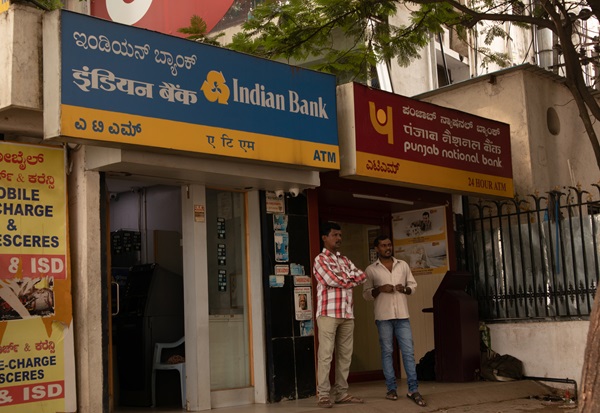.png)

Chokkalingam, Founder of Equinomics Research, has over 40 years of experience in economics and markets, leading research teams at top financial firms.
March 13, 2025 at 8:59 AM IST
The Nifty PSU Bank index has been one of the worst performers among major sectoral indices in the current meltdown in the stock markets. The index has crashed about 28% from its 52-week high, compared with about 14% fall for Nifty 50 from that level. However, individually, most public sector bank stocks have crashed 30-40%, from their respective 52-week highs.
Apart from the overall market meltdown, a significant slowdown in credit growth has also impacted PSU bank stocks. Industry credit growth has slowed down from as high as 15% in 2022-23 to about 13% in 2023-24 and further moderated to around 11% now. Other issues like a slowdown in deposit growth, a fall in the share of low-cost deposits and a decline in net interest margins also impacted the relative performance and stock prices.
Precedents
Historically, PSU bank stocks have tended to be extremely volatile – they plunged and subsequently they also created a lot of wealth for the investors.
A study of past episodes of crashes in the PSU bank stocks reveals an interesting insight. The year 2002 saw one of the worst monsoon with rains 19% below the normal. Consequently, most PSU bank stocks plunged and traded at 50-60% discount to their Adjusted Book Values (financial net worth minus outstanding net-non-performing loans). During the periods of the post-Lehman crisis (2007-2008), southern Europe debt issues (2011) and post-COVID pandemic (2020), PSU bank stocks also crashed, and a majority of them traded at significant discounts to ABVs.
One unique experience in all such periods is that PSB stocks saw a phenomenal recovery within a year or two and gave substantial wealth creation opportunities to equity investors.
Fundamental Improvements
Public sector banks enter this downturn with fundamentally healthier balance sheets. Gross NPAs have plummeted to a 12-year low of 2.6% (December 2024) from the precarious 14.58% levels seen in March 2018 – a cleanup exercise that positions them far better than during previous crises.
This improved asset quality coincides with record profitability: PSBs collectively posted ₹1.41 trillion in net profits during 2023-24, with 2024-25 expected to set new benchmarks.
Their shareholder value proposition has also strengthened, with ₹619.64 billion distributed as dividends over the past three years – a tangible return metric that didn’t exist at this scale during the 2008 or 2020 crash. Operationally, PSU banks now hold a surprising edge in low-cost deposits (CASA ratio of 38% vs private banks’ 37.8% in December 2024), supported by a large branch network. Recent diversification into gold loans – a ₹6.5 trillion industry growing at 15% annually – provides an additional revenue stream absent in prior downturns.
Valuation Argument
The current valuation setup mirrors to some extent historical inflection points. Most PSU banks now trade near 1x Adjusted Book Value or at discounts. Post the 2002 drought crisis (50-60% ABV discounts), 2008 meltdown, and 2020 pandemic, the subsequent 12-24 months saw index returns of 89% post-2020, 127% post-2008, and 215% post-2002. This time such phenomenal returns are most unlikely as valuation discounts are not comparable. However, market valuations of some of PSBs, which trade at discount to or little above 1x price-to-ABVs are likely to come back to average valuation of around 1.5x and thereby, create significant returns for the investors in the next one or two years.
Growth Catalysts
Public sector banks stand to benefit from four irreversible macroeconomic shifts:
Scale of Opportunity: India’s banking credit base has grown exponentially from ₹7 trillion in 1995 to over ₹179 trillion today – a 25x expansion that provides PSBs with a massive runway. Even at moderated 11% year-on-year growth, this translates to ₹19.7 trillion in fresh annual credit deployment.
GDP Multiplier Effect: With India’s GDP projected to grow at 6.5% in 2025-26, PSU banks are primed to capture demand across sectors. Historically, every 1% GDP growth correlates with 2-2.5x credit growth in developing economies – a dynamic that could push industry credit expansion back to 15%.
Value-Unlocking Potential: Many PSU banks house subsidiaries in high-growth segments like asset management and insurance. As these units mature, potential listings could lead to value unlocking for parent banks through stake monetisation and possible valuation re-rating.
Digital Adoption Dividend: While not quantified in legacy models, PSU banks digital transformation has reduced operational costs by 18-22%, according to industry estimates, since 2020. These savings flow directly to net interest margin environment.
Risk Factors
While better positioned, PSU banks face evolving headwinds. Small finance banks now command 8% of system deposits versus 3% in 2020, while microfinance institutions serve 70 million customers – a base growing at 24% CAGR. However, PSU banks retain structural advantages: 85% of India’s 158,000 bank branches, critical for mobilising sticky CASA deposits. The industry-wide CASA ratio decline (down 500 bps since 2021) remains a concern, but PSU banks’ 38% ratio still edges out private sector peers.
PSU banks combine cyclical recovery potential with structural improvements in asset quality, profitability, and digital adoption. With valuations near historical turnaround levels and a ₹179 trillion credit base supporting growth, they appear positioned for wealth-creation cycles despite new competitive challenges.




